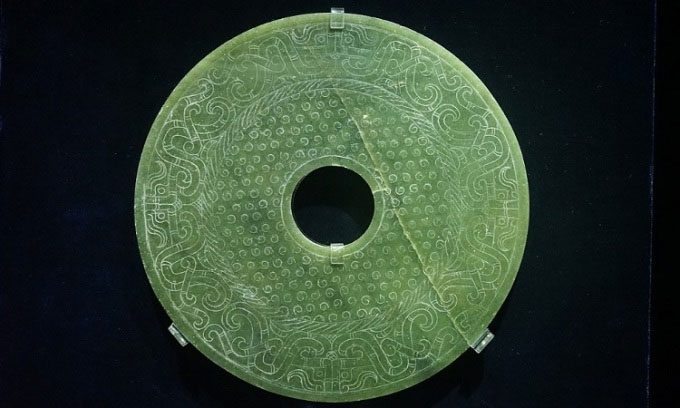Archaeologists Discover Jade Discs in Thousands of Years Old Graves, Yet Their Function and Crafting Process Remain Unclear.
In ancient China, at least since 5000 BC, large stone discs were placed on the bodies of nobles. Their original function remains a mystery to scientists, as does the method of crafting, because they are carved from jade, a material that is extremely hard, according to Ancient Origins.

Jade disc carved with a dragon unearthed in Yunnan. (Photo: Wikipedia).
Jade is a rare, hard stone composed of various silicate minerals, commonly used for making vases, jewelry, and various decorative items. This stone is typically colorless, but if it absorbs other materials like chromium, it can appear emerald green. There are two main types of jade: nephrite and jadeite. Due to its natural hardness, jade is a material that is very difficult to work with. Thus, researchers are still puzzled as to why the people of Neolithic China chose such a stone.
Since jade discs were produced during a time when no metal tools have been found, archaeologists believe they may have been created through heating and polishing processes, which would have required an extremely long time. The jade discs, flat and ring-shaped, were crafted from nephrite by the Liangzhu culture, which developed at the end of the Neolithic period from 3300 to 2300 BC. Their exquisite jade artifacts are thought to have served ritualistic purposes, showcasing complex craftsmanship and intricate production processes. Many items bear symbols related to the heavens (tian).
Discovered in numerous noble graves from the Hongshan culture (3800 – 2700 BC) to the Liangzhu culture (3000 – 2000 BC), jade was positioned prominently on the deceased’s body, such as on the forehead, chest, and soles of the feet. One hypothesis suggests that jade discs were intended to guide the souls of the deceased to heaven. Another theory posits that ancient people believed jade could prevent the body from decaying. Jade discs likely played a role in rituals or customs related to transitioning to the afterlife. At 50 excavation sites in Zhejiang Province, China, many walls, workshops, and tombs adorned with jade have been found.
Some researchers believe that jade discs symbolize the Sun or a wheel, reflecting the cyclical nature of life and death. Through jade discs, the people of the Liangzhu culture may have expressed their understanding of the endless journey of life through various stages.


















































